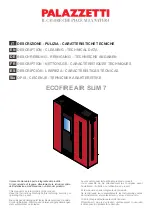
HearthStone Quality Home Heating Products Inc
®
Heritage Model 8021
6
Setting Up Your
Heritage Wood Stove
U
NPACKING
HearthStone Stoves packages your Heritage stove with
the greatest care, so that it ships safely. Under certain
circumstances, however, damage can occur during transit
and handling. When you receive your stove, unpack it
carefully, inspecting your stove and all parts for damage.
Also, make sure that all parts are included in the box. If
any parts are damaged or missing, please contact your
dealer immediately.
I
NSTALLING
Y
OUR
S
TOVE
First, you must decide where your stove will reside. After
choosing an appropriate spot, inspect this location to
make sure that the stove will have enough clearance to
combustible materials that would surround the stove.
These combustibles can include walls, floor, ceiling,
fireplace, and chimney. You must carefully consider the
clearances to all of these combustibles before actually
connecting your stove. When considering these
clearances, also decide the kind of floor the stove will rest
on. Unless it is being installed on non-combustible
flooring, a floor protector with an R-value of 1.2 is
required.
Please use this section to plan how to locate your stove in
your particular location. Consider both the clearances of
the stovepipe and the stove itself to the surrounding
combustibles. Also consider access to the side door.
The soapstone walls of the Heritage soapstone stove
produce and even, radiant heat. Locate the stove centrally
in your living area to allow the heat to travel naturally to
distant rooms. It is not recommended that you locate your
stove in an uninsulated basement. The amount of radiant
energy required to heat concrete basement walls is so
great that most of the usable heat is absorbed by them and
lost.
Read this chapter to obtain a sound understanding of how
to properly install your stove.
If you use a close clearance connector pipe, it must be
tested to UL standards and listed. Check the listing of
your pipe for actual clearances. The diagrams in this
manual represent typical installations, but are specific to
the Simpson Dura-Vent DVL brand. Clearances cannot
be reduced without the use of close clearance connector
pipe and/or by protecting the surfaces per NFPA 211
standards.
Clearances To NFPA 211 Protected Surfaces
You can reduce the clearances to combustible surfaces by
using any National Fire Protection Agency (NFPA)
approved wall protection system. Please refer to NFPA
211 for specifications and complete details. You can
obtain this information directly from NFPA.
National Fire Protection Agency
Batterymarch
Park
Quincy, MA 02269
1-800-344-3555
1-617-770-3000
H
EARTH
R
EQUIREMENTS
A
ND
F
LOOR
P
ROTECTION
Combustible flooring must be protected with a covering
of noncombustible material with an R-value of 1.2 (slate,
marble tiles, or other noncombustible material can be
used for this purpose). The floor protection must extend
beyond
the body
of the stove at the minimum as follows:
•
LEFT SIDE 16” (40.64 cm)*
•
RIGHT SIDE 8” (20.32 cm)
•
REAR 2” (5.08 cm)**
•
FRONT 16” (40.64 cm)*
* Installations in Canada require 18” (45.72 cm) of floor
protection on the left side and front.
** Rear clearance required only if stovepipe runs
horizontally back from the top or rear of the stove.
FLOOR PROTECTOR
14 1/2"
37cm
(U.S.)
14 1/2"
37cm
(U.S.)
47"
119cm
(U.S.)
37 1/2"
95CM
(U.S.)
16 1/2"
42cm
(CAN.)
3 1/2"
9cm
2"
5cm
2"
5cm
39 1/2"
100cm
(CAN.)
49"
124cm
(CAN.)
16 1/2"
42cm
(CAN.)
Note:
Dimensions shown in figure above are measured
from the legs of the stove, not the body.








































